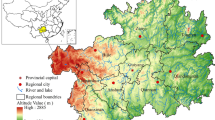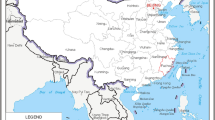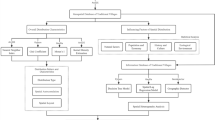Abstract
Traditional villages are precious historical and cultural heritage. Here, we investigate Fuzhou area of Jiangxi Province, China, and consider 114 national-level and provincial-level traditional villages, applying fieldwork, historical document searches, GIS spatial analysis, spatial syntax analysis, and other methods to explore the spatial form characteristics of traditional villages in this area on a macroscopic and microscopic (individual) level, and the relationships between scales. It is found that on a macroscopic regional level, the spatial distribution of traditional villages is unevenly distributed at a low altitude and at a close proximity to water systems; while on a microscopic level, traditional villages are mainly small and medium-sized, with landscape environments mainly determined by eight different types of waterfront hills. Among the four types of village boundaries, there are more villages with finger-like characteristics, including finger-like villages with banded features and finger-like villages with cluster characteristics. The living environment patterns mostly determined by four different types of comb settlements due to the limitations of regional environments as well as the topographic and cultural factors. Our results are significant for the improved evolution, protection, and development of traditional villages such as those found in the Fuzhou area.
Similar content being viewed by others
References
Chen D B, Song Y H (2009). On the ecological significance of the Feng shui ideal living model in China. Shanxi Archit, (35): 22–23
Chen J K, Wang T W, Liang Z Y (2018). Business layout of traditional villages based on spatial analysis and optimization strategies — a case study of Zhaji village in Anhui Province. Archit Culture, (8): 165–167
Chen Y H (2021). Analysis of the spatial structure of traditional villages from the perspective of space syntax: taking Gaotiankeng Village as an example. Beauty and Times (Urban Edition), (10): 35–37
Cao W, Zhu P H (2019). Quantitative evaluation of town master planning boundary based on fractal theory. Urban Develop Res, 26(8): 18–22
Deng Y Y, Fu X X, Zheng W W, Zhang H B (2021). Representation, measurement and attribution of spatial order of traditional villages in southern Hunan. Geogr Res, 40(10): 2722–2742
Entrikin J N, Paul C Adams, Karen E Till (2001). Exploring Humanist Geographies. Chicago: University of Minnesota Press
Ebert D (2004). Applications of archaeological GIS. Can J Archaeol, (28): 319–341
Fu J, Huang D (2016). Research on the traditional villages morphology pattern of Zengcheng, Guangzhou City based on the GIS spatial analysis. South Architect, (4): 80–85
Hu Y, Chen S, Cao W, Cao C Z (2014). The concept and cultural connotation of traditional villages. Urban Stud, (21): 10–13
He S Y, Zheng H, Tang Z (2018). A research on the construction of urban historical and cultural heritage management information system based on GIS. Guangdong U Techn, (35): 38–44
Hong Y L (2018). Research on the comb shape villages in canton conference during the Qing dynasty. Dissertation for the Doctoral Degree. Guangzhou: South China University of Technology
Liu D J, Hu J, Chen J Z, Xu X T (2014). Research on the spatial distribution pattern of Chinese traditional villages. Chin Populat Resourc Environ, (24): 157–162
Li D H, Xu C, Yang L, Ruan Y R (2018). (2018). Study on the spatial morphology of Lahu ethnic villages in Lancang County based on the quantitative analysis of settlements. J Yunnan Agricult U (Social Science), 12(6): 22–28
Li M, Rui Y, Wang C X, Ji Y, Li Y N (2018). Spatial distribution and influencing factors of traditional villages: a case of Wuyue Culture Region. Res Environ Yangtze Basin, (27): 1693–1702
Li W D, Wang G Q (2002). View on the development of country fairs of Fuzhou in Ming and Qing Dynasties. J Jiangxi Agricul U, 1(2): 88–92
Li Y T, Zhu Y Q, Zhou Y, Sun Z Q (2020). Quantitative study of the spatial morphological characteristics of villages based on fractal theory: Nanning Village as an example. Southern Archit, (5): 64–69
Lv M J, Guo W J (2016). The dynamic hierarchy and spatial differentiation of rural settlements in resource-based region. Econ Geogr, (36): 126–134
Sun J T, Niu J J, Zhang K K, Shao X Y (2017). Spatial distribution and influential factors of traditional villages in Shanxi. Human Geogr, (32): 102–107
Tong Y Q (2014). Research on the spatial differentiation of Chinese traditional village based on GIS. Human Geogr, 29(4): 44–51
Tan Q X (1982). The Historical Atlas of China. Beijing: SinoMaps Press
Wang T (2006). Comparative study on the landscape pattern of different restoration watersheds in hilly-gully region of loess plateau. Dissertation for the Doctoral Degree. Yangling: Northwest A&F University
Wang X W, Zhou J (2011). The evolution of traditional village pattern: case study of Liang Village in Shanxi. Modern Urban Res, 26(4): 30–36
Wang H Q, YuanJ D, MengX J (2017). Spatial distribution and its influencing factors of level-a scenic spots in Northeast China. Sci Geograph Sin, 37(6): 895–903
Xie D (2015). Study on spatial morphology of rural settlement in northern Dissertation for the Doctoral Degree. Haikou: Hainan University
Xie D, Pei B J, Yang D H (2015). Quantitative research on the spatial form of rural settlement in northern Hainan. Nat Sci J Hainan U, 33 (3): 277
Yang X (2020). Advances in quantitative research methodologies for the spatial layout of rural settlement in recent 20 years. Urban Plann Inter, 35(4): 72–80
Acknowledgments
This work was supported by the National Natural Science Foundation of China (Grant Nos. 41701514 and 52068034), Natural Science Foundation of Jiangxi (No. 20161BAB213074), and Key Laboratory of Poyang Lake Wetland and Watershed Research (Jiangxi Normal University), Ministry of Education (Nos. PK2021007 and PK2017005).
Author information
Authors and Affiliations
Corresponding author
Rights and permissions
About this article
Cite this article
Duan, Y., Yan, L., Lai, Z. et al. The spatial form of traditional villages in Fuzhou area of Jiangxi Province determined via GIS methods. Front. Earth Sci. (2022). https://doi.org/10.1007/s11707-022-0986-1
Received:
Accepted:
Published:
DOI: https://doi.org/10.1007/s11707-022-0986-1




